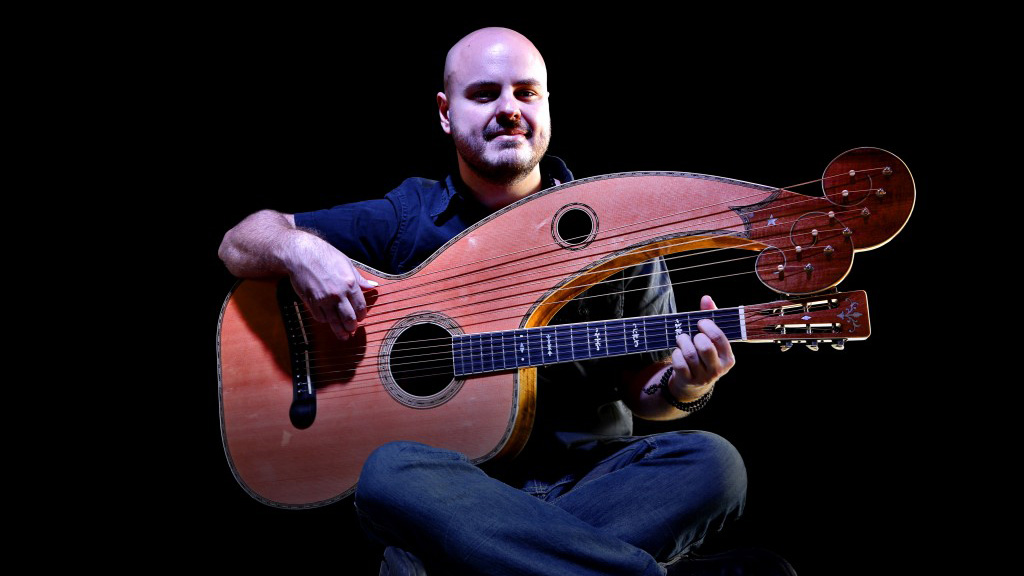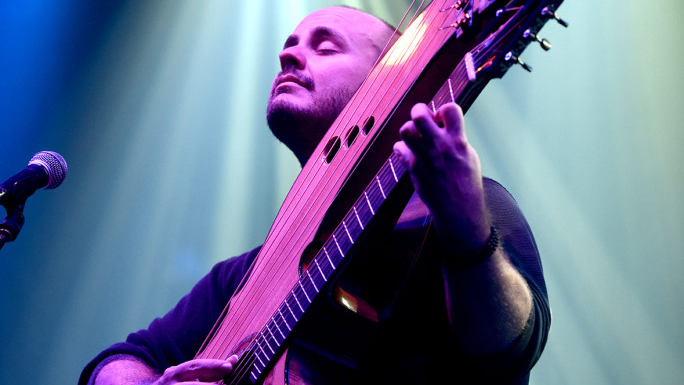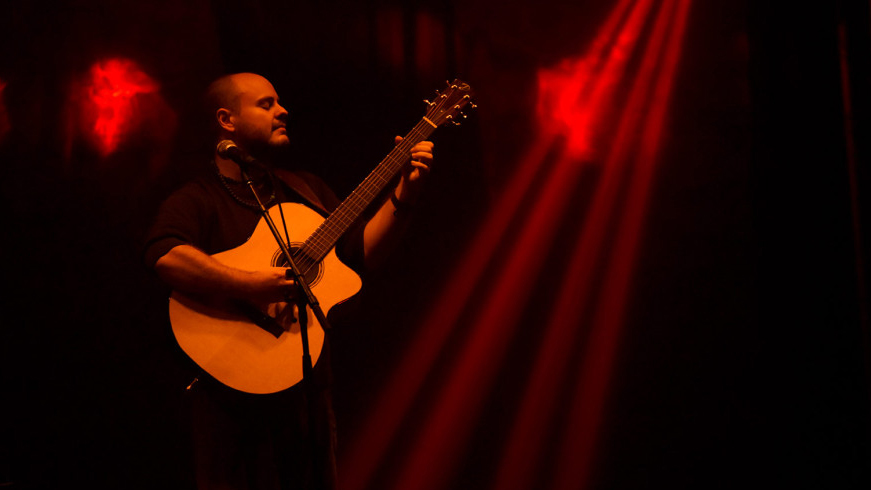Andy McKee’s top 5 tips for guitarists
Acoustic whiz shares technique advice and top-secret alternate tunings

American fingerstyle virtuoso Andy McKee has amazed the world in numerous ways since picking up the guitar at the age of 13. But of them all, perhaps the most mind-blowing for him is being headhunted by one of the greatest musicians of all time in Prince…
“He found me on YouTube and contacted me about getting together to see what would happen,” remembers Andy.
“I had no idea anything like that would ever happen to me, so I went to Minneapolis. He was really interested in what I was doing on acoustic, though he wasn’t too sure where it was going and neither was I - but he suggested trying to do some shows together. I thought maybe we could do an instrumental album; we talked about that after the Australia tour.”
Prince never called me Andy; it was always Mr McKee!
As fate would have it, the music superstar's tragic passing in April 2016 meant the idea would never come to fruition.
“I felt a little out of place in terms of the whole show,” continues Andy.
“I like to express myself with an acoustic and do what I do. Being in someone else’s band wasn’t really my thing, I guess. And I told him that after the tour, and he would still email me saying we should do an acoustic album, so we exchanged a few ideas in December 2015. Then just a few months later, he passed away.”
Being someone few ever got the chance to meet or spend one-on-one time with, you can’t help but wonder: what was Prince like to work with?
“He never called me Andy, it was always Mr McKee!” laughs the guitarist, “which was a little bit unusual, haha!
“He was very professional and respect. Sometimes he’d have these little parties after the show, he’d mainly be chilling in the back. He was eccentric but reclusive too; he was kinda quiet most of the time, to be honest.”
Greenfield-fingered
This October, the musician will be returning for an extensive tour across the UK and Ireland - so expect to see a few of those Greenfield guitars he’s famous for playing…
“I discovered those guitars about 13 years ago,” he notes.

“I was at a guitar festival in Canada and he had a display, so I ended up trying them out and fell in love. They’re just so well made and sound fantastic. They look amazing, too!
“When I play a live show, I hardly have any EQ going on - and I don’t use effects other than a bit of reverb. It’s the K&K Mini pickup going into a D-Tar Solstice preamp.
“That’s all you’re hearing… there’s no real processing going on. It’ll probably be the harp guitar, the baritone and one or two more, and I should hopefully be playing a couple of new tunes from the next album, as well as older stuff, too.
“I was always drawn to instrumental music, even from a young age, listening to people like Vince DiCola, who did the Rocky IV soundtrack. I’ve always had more of a connection to music than lyrics, I guess.”
Here, the virtuoso gives us five tips to hone our craft…
Andy McKee plays London's Under The Bridge on 7 October 2017.

1. Train your ear
“One thing I focused on growing up was learning things by ear. These days, it’s getting harder because it’s so easy to go and find a video on YouTube of someone playing what you want to learn and pick it up that way.
You can figure out the tuning if you listen closely to open strings and harmonics - all these little things that can give it away
“But if you can, resist the temptation, sit there with an mp3 player or whatever, and try to just listen to the music.
“You can figure out the tuning if you listen closely to open strings and harmonics - all these little things that can give it away. I would always do it note-by-note, literally pausing my CD or cassette tape to find the right note and think about the next one.
“You can really develop your ear by doing it that way and it will all help when you come to writing your own music, too. That sound you want to create, you’ll already somehow know how to play it.”

2. Open your mind
“As far as composing goes, I like to use a lot of open tunings. The reason for that is that it brings me a whole new instrument. Okay, not an actual new instrument, but all the notes will have changed and that will force you in different ways.
“If you’ve learned so many chords and scales, you know how they sound and you just need something different; I would really recommend experimenting with open tunings. Suddenly, you’ll have all these new chord voicings available, some that are impossible on a standard tuned guitar. You’ll come up with new ideas on the spot.
“Here are some I’ve used on a couple of tunes, from low to high: B, G, D, G, A, D - which is like a G major add9, but an inversion with the B on the bass. That one’s a lot of fun and I ended up using it for She and Never Grow Old.
“Another is E, C, D, G, A, D - that one has the fifth string raised a step-and-a-half, which is a bit risky, but it sounds so cool. I use it on For My Father, Rylynn, Keys To The Hovercar.
“And more is D, A, D, E, A, C# - which is the D major 9 kinda tuning used for Mythmaker, though it’s on a baritone so it’s a fourth lower.”

3. Take the right-hand path
“The right hand is one of the first things you need to focus on when switching over to fingerstyle. It can be a bit of a challenge at first. What I normally do is assign my thumb to the sixth, fifth and fourth strings, then my index on the third, next on the second and the ring finger on the first.
“That’s my basic approach, and I feel like it’s a great place to start. If you experiment, even in standard tuning, there are all sorts of patterns that it’s good to get familiar with. Alternating bass with the thumb is a great place to start - it gets that feeling of rhythm in all your fingers.”

4. Rock your body
“Another thing I’m known for, though funnily enough I haven’t actually done too many songs using it, is percussion on the guitar. Of course there’s the song Drifting, which went viral, so I guess a lot of people know me from that tune. But there’s actually only about three songs with me banging on the guitar body like that. It’s a great way of making tunes more interesting.
“If you experiment with hitting the body in different places, you’ll find the sounds that work for you. I’d say there’s a good kick drum sound with the heel of your right hand on the lower bound of the guitar, and a good snare sound on the side.
“Another good snare could be taking your right hand thumb and clicking it against the strings on the two and the four. Underneath a snare you have wires there, so it’s a bit like what the guitar strings are doing when you hit them like that.
“There are all sorts of rhythmic effects you can incorporate in your music even without hitting the guitar body.”

5. Learn to multi-task
“I don’t know if this a technique thing, but one thing that drew me to acoustic from electric was discovering guitar players like Preston Reed, Michael Hefner and Don Ross. What I found fascinating was how they played rhythm, melody and harmony all at once on one guitar!
“I’d been into hard rock and metal stuff, I loved all the riffs and solos, but seeing all these things done at once blew me away.

“If you’re thinking about composing music like this on an acoustic, I’d say it’s important to remember all three aspects. Come up with a cool riff, the next thing to do would be to add a melodic idea on top while keeping as much of it as possible.
“You might have to alter it to make the melody work, but you can still imply the riff is going on. That’s how you make it work as a fingerstyle soloist.
“If you have a cool percussive idea that kicks ass, that’s great - but you have to go somewhere with it. Maybe imagine a melodic statement like what someone would sing floating over the top of it.
“All these bases need to be covered to keep it interesting for people. It doesn’t have to be complicated; sometimes the melody will just carry it all the way and that’s what people will latch on to.”
Amit has been writing for titles like Total Guitar, MusicRadar and Guitar World for over a decade and counts Richie Kotzen, Guthrie Govan and Jeff Beck among his primary influences. He's interviewed everyone from Ozzy Osbourne and Lemmy to Slash and Jimmy Page, and once even traded solos with a member of Slayer on a track released internationally. As a session guitarist, he's played alongside members of Judas Priest and Uriah Heep in London ensemble Metalworks, as well as handling lead guitars for legends like Glen Matlock (Sex Pistols, The Faces) and Stu Hamm (Steve Vai, Joe Satriani, G3).
